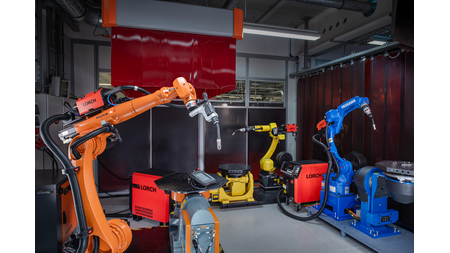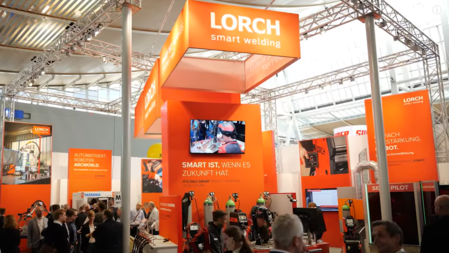Collaborative and even more efficient welding with the new Cobot Move by Lorch
The new Cobot Move linear axis by Lorch Schweisstechnik significantly extends the previous application options for Cobot welding: The Cobot’s working radius is increased to more than 4.5 metres thanks to a traversing axis, making it possible to set up much larger workpieces or using multi-station operation on a single worktable. One important special feature of the Lorch solution is the Cobot’s ability to operate without any safety enclosure, permitting easy integration into existing working environments without any great effort.
Lorch Schweißtechnik, a pioneer and market leader in Cobot welding, continues to expand its range with the new Cobot Move. Companies will now be able to weld larger workpieces, or several smaller ones clamped on a worktable, automatically even more easily, clearly increasing their manufacturing efficiency. The core of this new solution is a linear axis with a traversing range of 2,000 millimetres, operated with a high-precision repeatable ball screw drive that achieves traversing speeds of 2 to 160 mm per second. The linear axis can be mounted on any standard welding worktable with a length of at least 2.4 metres. Even already-installed Cobot Welding Solutions with a UR 10e Cobot can be retrofitted with the linear axis easily to extend the Cobot’s working range to more than 4.5 metres.
Various special features help make the solution even more effective. The Cobot can still be used collaboratively and remains CE-compliant. In contrast to any comparable robot solution, it can be used without any additional safety technology such as laser scanners or protective enclosures, which makes installation very quick and easy, and greatly simplifies integration into the existing production environment. Lorch is currently unique on the market with this fully collaborative feature.
Another advantage of Cobot Move is that welding is also possible while the Cobot is traversing on the linear axis. The Cobot joint position will not change at any point, ensuring a uniformly high-quality result of the weld seam. Even very long parts that used to require time-consuming repositioning can now be welded efficiently in a single continuous step thanks to the enlarged working area.
The use of the linear axis also brings great advantages with the so-called "nesting operation", in which series components are welded one after the other on a work table in multi-station operation. Once the first component has been programmed, all subsequent ones can be welded simply by moving the Cobot. The joint position of the Cobot remains the same for each component and guarantees an optimal weld seam. This increases the Cobot’s working space at constant repeat quality. However, nesting operation not only reduces programming effort but also significantly increases productivity: While the Cobot is welding in one station, workpieces can be prepared for the next welding process in other ones at the same time.
Users can use the URCap Lorch Motion with a number of control options for programming the Cobot Move. This software is just as user-friendly as the powerful Cobotronic for all Lorch Cobot solutions. The Cobotronic itself has many additional functions for the user, to be flexibly activated at need. Some of these are the QuickPoints function for easy programming of waypoints and welding commands at the touch of a button, or the SmartCopy one that allows copying of welding sequences once programmed for a part to transfer them to identical parts in different positions in the Cobot’s workspace. The latest innovation in this area is the automatic SeamTracking weld correction, allowing the Cobot to follow a weld seam’s course and warranting best welding quality, even if the workpieces are slightly distorted or a bit outside of the tolerances.
Dr. Ing. Caren Dripke, department head of robotics development at Lorch Schweißtechnik: “The Cobot Move is the perfect complement to our welding Cobot. The additional linear axis not only opens up a significantly larger working area, permitting automated welding of longer and larger workpieces and significantly increasing output in the production of series parts. Its sophisticated axis design also permits unchanged collaborative operation of the system. This means that the system retains its typical flexibility and full accessibility without compromising on safety. This solution is unique on the market at this time.”
Téléchargements
- 01_Lorch_Cobot_Move_Linearachse.jpg
- 02_Lorch_Cobot_Move_kollaborativ.jpg
- 03_Lorch_Cobot_Move_Integration.jpg
- 04_Lorch_Cobot_Move_Grafik.jpg
- 05_Lorch_Cobot_Move_Serien.jpg
- 06_Lorch_Cobot_Move_Tracking.jpg
- PI_Lorch_Cobot Move_EN.docx
- PI_Lorch_Cobot Move_NL.docx
- PI_Lorch_Cobot Move_FR.docx
- PI_Lorch_Cobot Move_IT.docx


